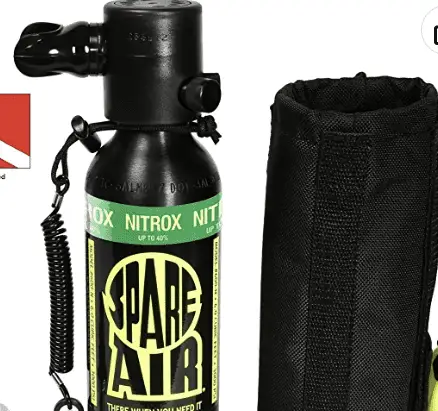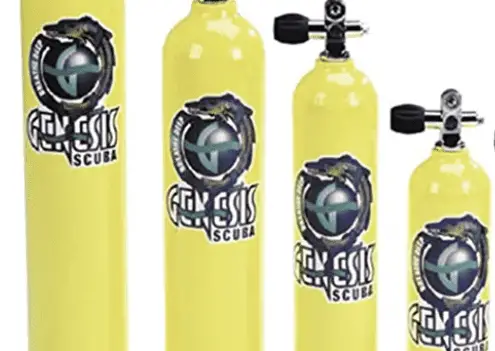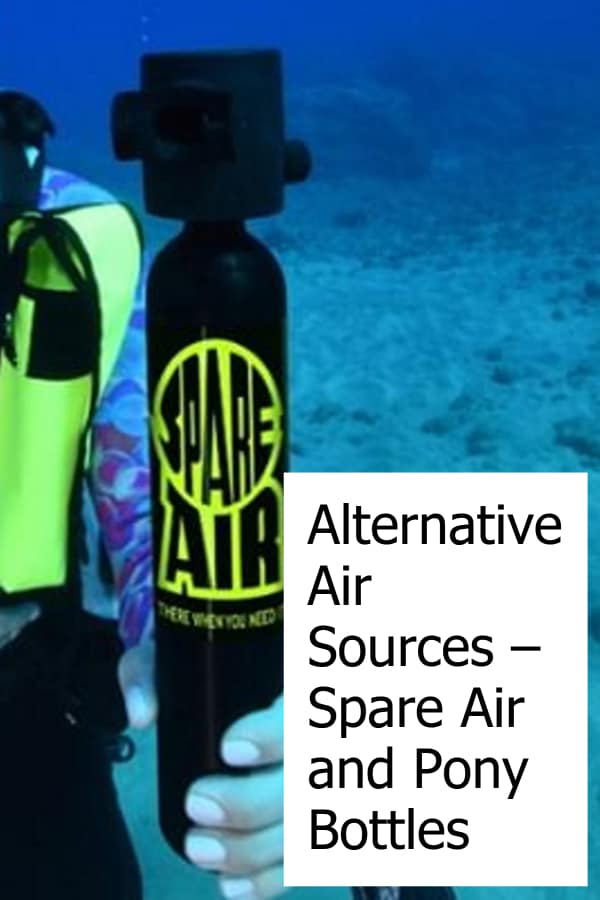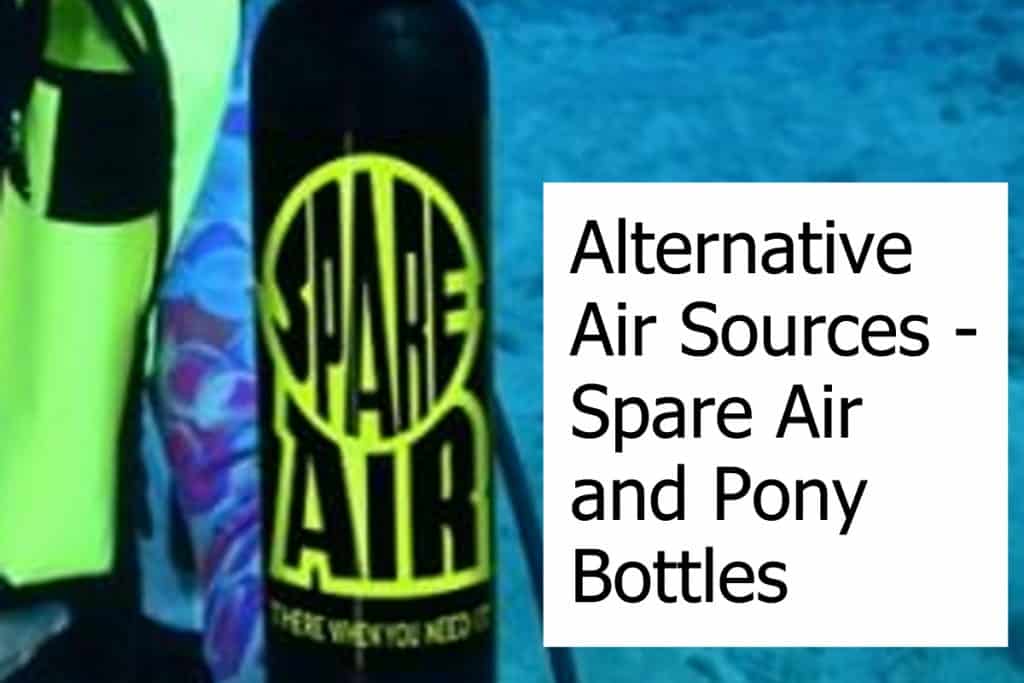Emergency Alternative Air Sources – Spare Air and Pony Bottles
Do you hear pony bottle and your first thought is a tiny pony in a bottle that you take on your scuba dive to show the sights underwater?
Hmmm… Maybe it’s time to take a refresher course before you go scuba diving again and then come back to get a better idea of what Spare Air and pony bottles are.
Otherwise, have a look below to find out which alternative air source is the better choice for you!
Sometimes, divers underestimate how long they will be underwater and how much air they will need. Other times, they encounter a problem while diving, like a gas leak out of their tank.
Either leads to an air emergency where the diver might run out of air. Using a small scuba tank like pony bottles or spare air is the solution for self-rescue during such an emergency!
Inevitably, even the safest, most knowledgeable divers will eventually find themselves in dire need of air. It’s a reality that should be planned for every time.
What are alternative air sources?
Though some people do swim with a second full-sized tank as their alternative air source, this method is cumbersome. For this reason, alternative air sources, which are basically small scuba tanks, were designed. They are only meant to be used in the event of an emergency.
Each diver has their own preference for alternative air depending on the situation, with some preparing two different alternative sources for a single dive. We recommend practicing with all the options under safe circumstances, in order to understand the benefits and limitations of each source. The two types of alternative air sources we will be going over are both known as “bailout cylinders” that are your safety net when you for whatever reason can’t get air through the octo of your buddy.
We’re having a closer look at Spare Air vs Pony Bottle – small diving tanks to use as an alternate air source if you run out of oxygen underwater or your regulator stops working!
Using any such small scuba tank in an emergency is usually the last resort you have in an air emergency underwater. Your first choice would be to use the octopus regulator of your dive buddy and you both ascend safely to the surface. However, there can and might be circumstances where a dive buddy is not around and divers in trouble need air to safely ascend to the surface.
What is Spare Air?
Spare Air is the brand name of the world’s smallest replacement air system for divers. Packaged in small aluminum tanks, about 8-12 inches tall and 2 inches in circumference, Spare Air pony bottles offer a few quick breaths to a diver in an emergency through a standard rubber scuba mouthpiece.

How long does Spare Air last?
They are not fitted with hoses or pressure gauges but can be attached to the main scuba tank (How Long can a Scuba Tank Last?) through a valve opposite to the mouthpiece on the regulator body. The idea behind a Spare Air pony bottle is to allow the diver enough time to get to the surface, unencumbered by equipment.
Spare Air tanks come in two sizes. The small holds 1.7 cubic feet of air and supplies about 30 breaths, while the large holds 3.0 cu ft of air and supplies about 50 breaths. For many recreational dives that is enough to get you relatively safely to the surface – it won’t be enough to share with your dive buddy if you both run out of air!
Spare Air is a good choice for new divers because it requires little training to use. Newly certified divers will stick to relatively shallow depths while they’re practicing their skills, anyway. Spare Air is only intended for dives that will not require decompression – What is a decompression dive? If a diver should end up in a tricky situation where she’s running out of air, they can simply apply the nozzle to their mouth and safely ascend.
Are pony bottles the way to go?
Pony bottles are larger than Spare Air but still smaller than a full-sized scuba tank. They act as an extension of the scuba set and are fitted with independent regulators and gauges. In the event of an emergency, the diver will have to attach the bottle to its main air supply using a connector and open the valve.
You have to factor in that you do need a regulator for your pony bottle. Before every dive you need to check the setup similarly as you check your main air system!

How to define Hookah Diving – What do you need for a hookah dive system?
These bottles supply enough air to allow the diver to make a normal, safe ascent to the surface from mid to low depths. They are commonly sold in 6, 13, and 19 cu ft bottles, with 13 cubic feet being the most popular size.
For deeper dives, small tanks of both 30 and 40 cu ft are available. Smaller pony bottles will allow a safe ascent in most recreational dives, while larger bottles will allow a safe ascent that includes decompression stops.
During a dive, a pony bottle should be fixed to the main tank with clamps or straps. This allows convenient access and keeps them out of the way of the diver’s workspace.
Is one better than the other?
Both pony bottles and Spare Air are refillable while on land. Pony bottles are typically refilled via a scuba tank. The Spare Air pony bottle can be refilled using a scuba tank, personal breathing compressor, hand pump, or at your local dive shop.
Deep Dives – Pony Bottles can help with a safe emergency ascent
Pony bottles definitely provide more air and are a safer choice if you know how to quickly change your air source when you run out of air. They can save a diver’s life during a deep dive, but the air is not as easy to use in air emergencies as Spare Air.
A Pony bottle is not safe for inexperienced divers to use, and one should never attempt to dive with a pony bottle without practicing with them first. They can be quite bulky as even the smallest tank has a volume of 6 cu ft! The larger you size your small dive tank or pony bottle, the more gear you’ll be dragging with you!
Shallow Dives – Spare Air provides enough Oxygen to surface safely
In shallow water dives with small space requirements, Spare Air is a good, safe choice as your secondary air supply. However, Spare Air is a small solution to a small problem. If caught at low depth with no extra air supply, the diver would have to hurry to come up, which can be very dangerous.
Keep in mind though that even shallow dives can potentially require a decompression stop! In that case, the Spare Air will not provide enough air to perform a decompression stop to safely ascend! Even a larger Spare Air model that you use as your air source in case of an emergency can be too small to allow you to safely ascend.
Final Thoughts on Air Management
Ultimately, the choice comes down to experience. There is no perfect answer. A diver must look at the circumstances for each individual dive, and evaluate the risks. Dive tables are extremely helpful in calculating how much air one would need in an emergency, based on the distance to the surface and rate of consumption.
It’s always best to overestimate how much air will be needed. Adrenaline and fear typically cause people to breathe much more heavily, burning through their supply quickly. If space requirements are not an issue, then consider using two alternative air sources: one pony bottle and one Spare Air.
One final thought and warning. Do NEVER include the available gas you have in your alternate source of air in your dive calculations. These devices are only meant for air emergencies and should never be seen as an additional source of air to allow you to dive longer!


